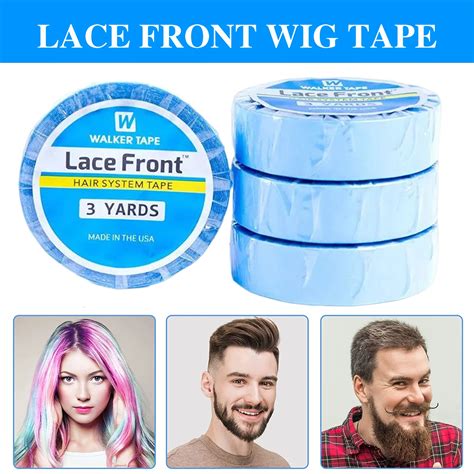Introduction
Wig adhesive tapes play a crucial role in ensuring the secure and comfortable attachment of wigs, providing peace of mind and enhancing the wearer’s confidence. With an estimated global wig market size of 25 billion USD by 2027, the demand for reliable adhesive tapes is on the rise. This comprehensive guide delves into the various types, benefits, proper application techniques, and tips for maximizing the effectiveness of wig adhesive tapes.

Types of Wig Adhesive Tapes
1. Foam Tapes:
- Cushion the scalp for comfort, reducing pressure and irritation.
- Ideal for sensitive skin or longer wear times.
2. Liquid Tapes:
- Form a strong, waterproof bond with the skin and wig cap.
- Provide long-lasting hold, even in humid environments.
3. Mesh Tapes:
- Ventilated mesh material allows for breathability, reducing sweating and discomfort.
- Suitable for delicate hairlines or extended wear.
Benefits of Wig Adhesive Tapes
- Secure Hold: Keep wigs firmly in place, preventing slippage or movement during everyday activities.
- Comfortable Wear: Cushion the scalp, minimizing pressure and irritation, making wigs comfortable to wear for extended periods.
- Waterproof: Liquid tapes create a waterproof barrier, protecting the skin and wig from moisture or sweat.
- Hypoallergenic: Specially formulated tapes minimize the risk of allergic reactions or skin irritation.
- Easy to Apply and Remove: Adhesive tapes are designed for simple application and removal, avoiding mess or damage to the wig.
Proper Application Techniques
- Cleanse Scalp: Remove any oil, dirt, or product residue from the scalp using an alcohol-free cleanser.
- Apply Tape: Peel a strip of tape and apply it to the scalp in thin, staggered lines, starting from the forehead and working towards the nape of the neck.
- Press and Hold: Firmly press the tape onto the scalp for 30-60 seconds to ensure secure adhesion.
- Trim Excess: Trim any excess tape around the edges of the wig cap using sharp scissors.
- Attach Wig: Carefully align the wig over the tape and press down gently to secure it.
Tips for Maximizing Effectiveness
- Use a Wig Cap: Wear a wig cap to create a barrier between the scalp and adhesive tape, reducing irritation and promoting longer wear times.
- Test for Allergies: Perform a patch test on a small area of skin 24 hours before full application to rule out allergic reactions.
- Avoid Overtightening: Tightening the tape too much can cause discomfort and damage to the skin or wig.
- Remove Regularly: Remove the wig and adhesive tape at least once a day, especially at night, to allow the scalp to breathe.
- Use Isopropyl Alcohol (91%): For easy removal, apply isopropyl alcohol (91%) around the edges of the wig and gently lift it off.
Step-by-Step Approach for Beginners
Step 1: Gather necessary supplies (wig, tape, cap, cleanser, scissors).
Step 2: Cleanse scalp and apply wig cap.
Step 3: Peel and apply tape to scalp in thin lines.
Step 4: Trim excess tape.
Step 5: Attach wig and press firmly.
Step 6: Secure with additional tape at sensitive areas (e.g., hairline).
Useful Tables
Table 1: Comparison of Adhesive Tape Types
| Type | Comfort | Waterproof | Breathability |
|---|---|---|---|
| Foam | High | Low | Low |
| Liquid | Medium | High | Low |
| Mesh | Medium | Medium | High |
Table 2: Popular Wig Adhesive Tape Brands
| Brand | Type | Price Range |
|---|---|---|
| Got2b Glued Blasting Freeze Spray | Liquid | $10-$15 |
| Ghost Bond Platinum | Liquid | $30-$40 |
| Walker Tape | Foam | $15-$25 |
| Ultra Hold | Mesh | $20-$30 |
Table 3: Tips for Different Wear Times
| Wear Time | Tape Type | Application Frequency |
|---|---|---|
| Short-term (1-3 days) | Foam | Daily |
| Medium-term (4-7 days) | Liquid | Every 3-4 days |
| Long-term (8+ days) | Mesh | Every 5-7 days |
Table 4: Troubleshooting Common Issues
| Issue | Cause | Solution |
|---|---|---|
| Skin Irritation | Allergic reaction | Use hypoallergenic tape or consult a dermatologist |
| Tape Slippage | Improper application | Cleanse scalp before applying, trim excess tape, and use additional tape at sensitive areas |
| Wig Movement | Loose tape | Re-apply tape or use stronger adhesive |
“Thinking Outside the Braid”: Innovative Applications
Beyond traditional wig attachment, adhesive tapes have untapped potential for innovative applications.
- Headgear Customization: Secure headbands, hair clips, and other accessories without damaging hair.
- Temporary Hair Extensions: Attach hair extensions for a quick and temporary style transformation.
- Special Effects Makeup: Use tape to adhere prosthetic pieces for realistic effects in movies or theatre.
Conclusion
Wig adhesive tapes are an indispensable tool for secure, comfortable, and versatile wig attachment. By understanding the different types, proper application techniques, and maximizing effectiveness tips, wig wearers can confidently embrace their desired looks, expressing themselves fearlessly and effortlessly.
